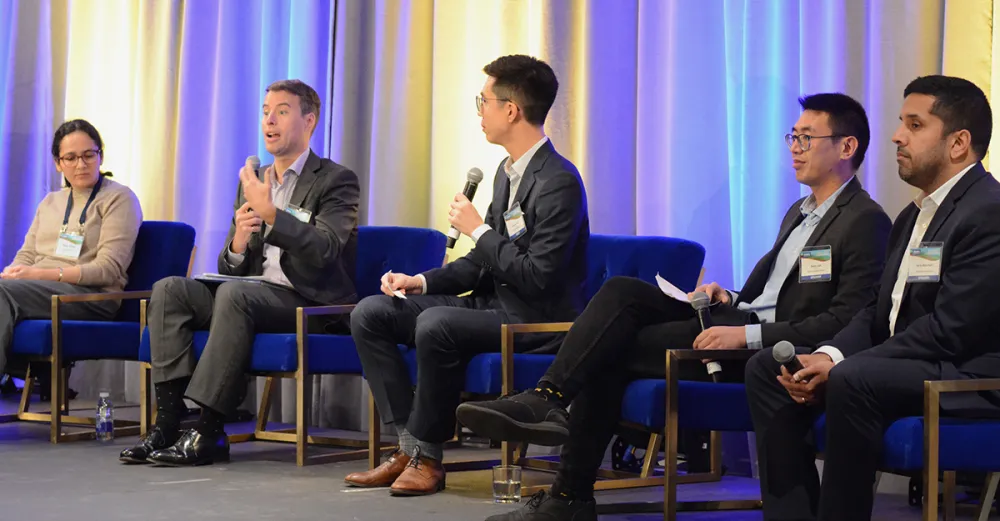CALGARY — Global sales of carbon removal credits surged into a vertical-line graph this month, providing an ideal backdrop for today’s Carbon Catalyst event in Calgary.
The one-day conference and workshop, held by the Pembina Institute’s Carbon Dioxide Removal Centre (CDR Centre), will share developments and lessons learned about the carbon dioxide removal industry in Canada.
“This is a significant turning point for the carbon removal industry in Canada: if we set up the right investment climate and market conditions, we could attract thousands of jobs and significant community benefits,” said Jorden Dye, director of the CDR Centre.
Carbon dioxide removal, commonly called CDR, is a suite of methods that literally pull carbon dioxide out of the air to reduce the damage being caused by climate change. Removing carbon dioxide from the atmosphere can be done anywhere in the world. But the industry also requires secure, long-term storage space in suitable geological formations, a jurisdiction with enabling legislative and regulatory frameworks, and a workforce with relevant skills.
Several provinces and the federal government are working towards ticking all those boxes. But there is urgency to the task. The U.S. administration under President Donald Trump froze funding for CDR projects, so suddenly we have an opportunity to attract what was a growing industry in the U.S. to our country instead.
This emerging industry could create 95,000 to 130,000 jobs per year, jobs that look a lot like oil and gas sector jobs, if we removed the equivalent of just 15 per cent of Canada’s annual emissions, according to a recent Rhodium Group report.
Communities stand to benefit, too. At Carbon Catalyst, Innisfail’s mayor will share how the town embraced the economic opportunity and welcomed a Canadian CDR industry leader, Deep Sky, to their community. Deep Sky is completing work on a carbon removal innovation and commercialization centre there. The locals are already benefiting. Take the story of Thomas Morton, who used his 40 years of experience in the oil and gas industry to become the centre’s first facility operator.
“We’re just getting started in Canada, but we need to act quickly,” said Dye. “We need to be able to remove a significant amount of carbon dioxide annually to reduce the impacts of climate change for future generations. That is meaningful work, and it can happen here. But businesses need to know this is a viable option that will allow them to reach their sustainability targets. And developers need to test and scale their technologies to provide us with the lowest-cost options to do this work.
“Our work at the CDR Centre will provide information and support to business leaders who want to seize this economic opportunity.”
Jorden Dye, CDR Centre director, is available for comment.
Quotes
“Canada isn’t just our home. It’s the ideal place for carbon removal innovation. With vast landscapes offering both massive geologic storage and abundant feedstocks, plus a workforce already skilled in resource development, together we’re building an industry that could create thousands of jobs while tackling one of our planet’s biggest challenges.
— Finn Tessier-Lavigne, Engineering Lead for Sustainability, Shopify
"The carbon removal industry isn't just our best shot at turning back the clock on climate change — it represents a once-in-a-generation economic opportunity for communities around the world. This emerging trillion-dollar global sector offers a pathway for skilled workers to apply decades of expertise in carbon extraction toward the vital new mission of carbon sequestration. At Deep Sky, we've seen firsthand how carbon removal projects can bring high-quality jobs, infrastructure investment, and renewed purpose to communities with deep energy expertise. This isn't just about new technology — it's about building lasting partnerships with municipalities that enable economic resilience while tackling our most pressing environmental challenges.”
— Phil De Luna, Chief Science and Commercial Officer, Deep Sky
“The race to scrub carbon dioxide from the atmosphere is on. With the U.S. retreating from action on climate, Prime Minister Mark Carney and his new government have a real opportunity to position Canada as a leader in that race. Exciting times for this growing Canadian industry await.”
— Ed Whittingham, Founder, Advance Carbon Removal
“CDR is the tool we need to cover the final mile of the race to net-zero. We have all of the resources we need right here in Canada to win this race. We need to start mobilizing them today to deliver on the promise of CDR."
— Sean McCoy, University of Calgary Assistant Professor, Schulich School of Engineering. CanCO2Re primary investigator
Quick facts
• Five to 10 gigatonnes of carbon dioxide must be pulled out of the air annually by 2050 to avoid the worst impacts of climate change.
• Twelve organizations worldwide have purchased more than 100,000 tonnes of advanced CDR credits.
Background
The Carbon Dioxide Removal Centre (CDR Centre) is an initiative of the Pembina Institute. The CDR Centre aims to build CDR awareness for decision-makers, spur CDR market activity in Canada and encourage public procurement of CDR.
Contact
Hanneke Brooymans
Senior Communications Lead, Pembina Institute
587-336-4396
Background resources
Report: A scan of carbon dioxide removal buyers in Canada (2024)
Case study: MaRS Discovery District Carbon Dioxide Removal Pre-purchase




